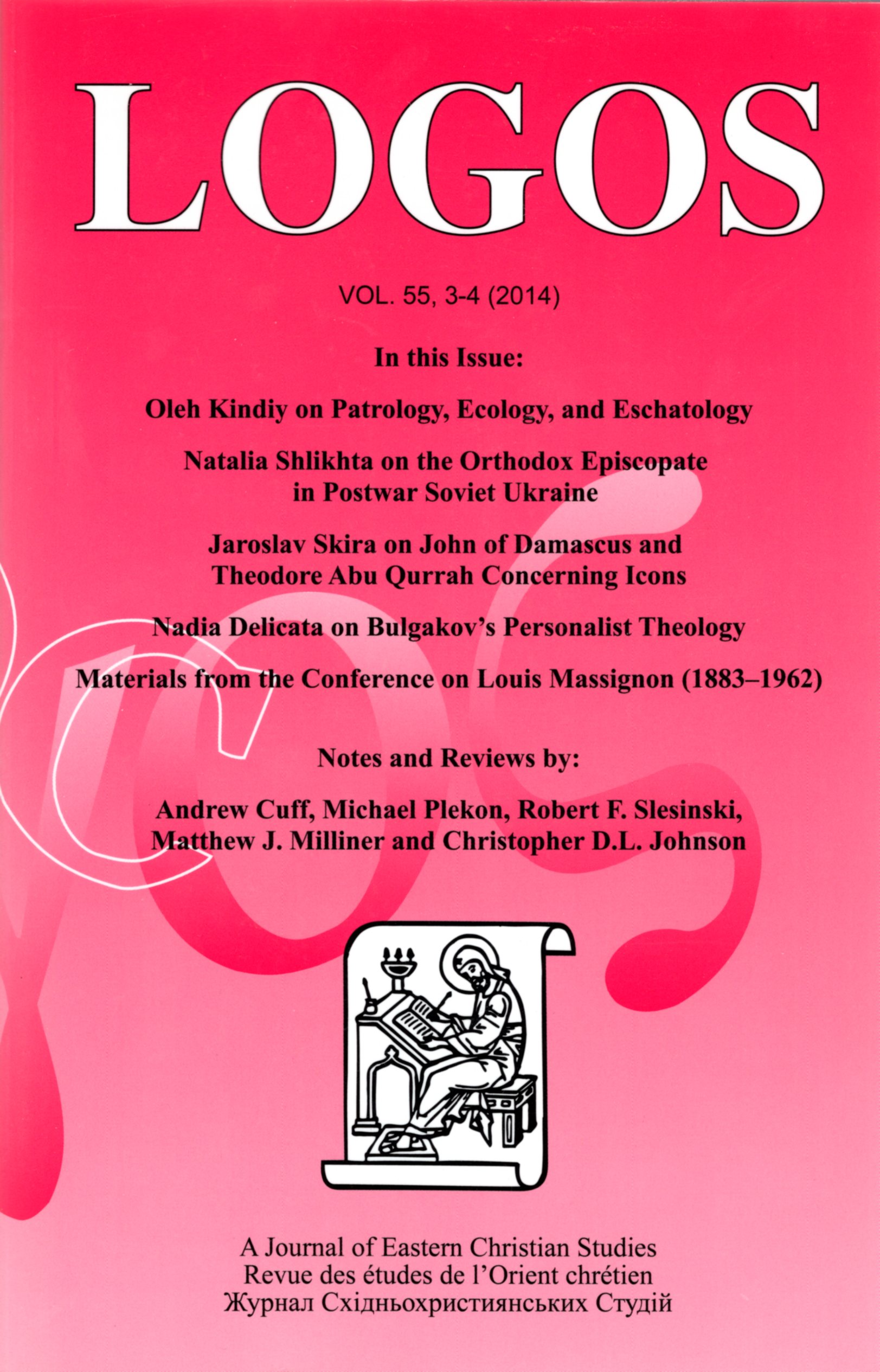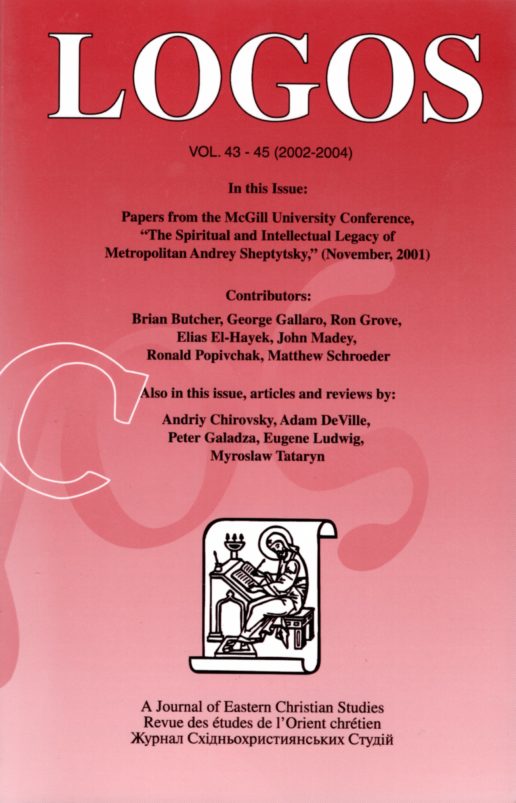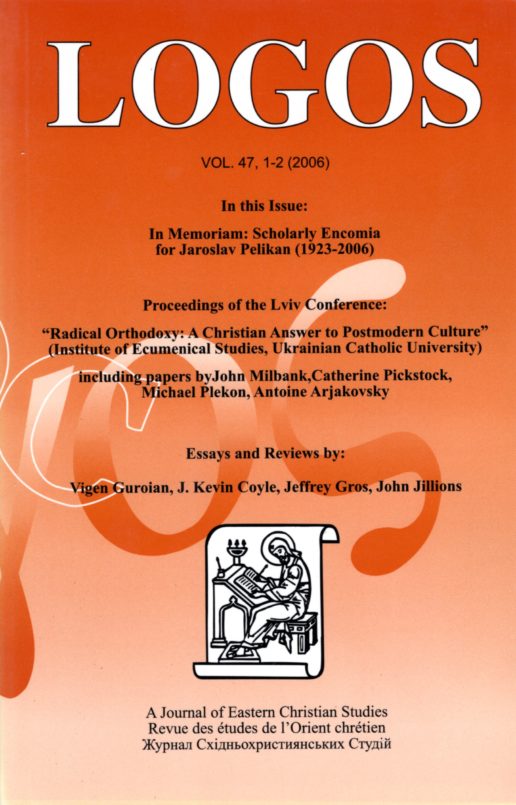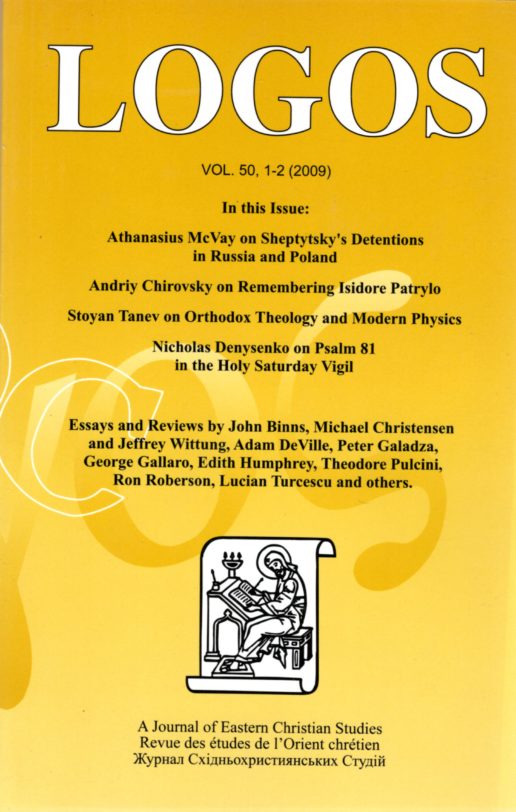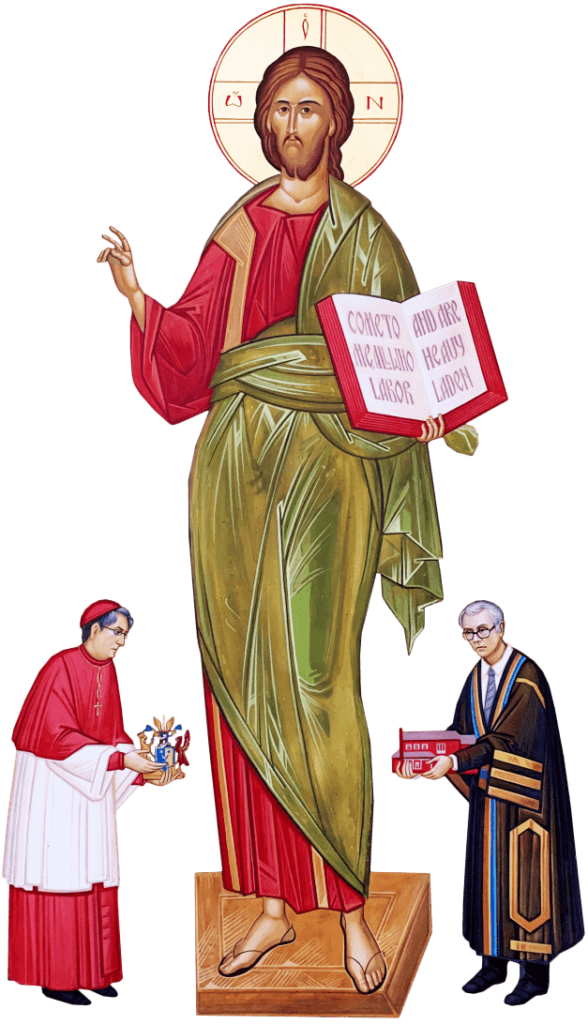Description
Table of Contents (PDF sample)
Editorial
Good and Bad News Regarding the Conflict in Ukraine: A Revolution of Dignity and an Ecumenism of Engagement (PDF Open Access)
Andriy Chirovsky (289)
Articles
Patrology, Ecology, and Eschatology: Looking Forward to the Future of the Planet by Looking Back to the Fathers of the Church (PDF sample)
Oleh Kindiy (303)
Abstract
Nearly a half-century ago in an infamous article, Lynn White Jr. accused Christianity of being complicit in environmental degradation, a claim that has met with widespread rebuttal. And yet, there are signs today of renewed ecological degradation in manifold forms, and peoples of all intellectual disciplines and backgrounds are struggling to respond to these challenges. Theologians have their role to play, and this article shows that there are deep theological resources within early Christianity addressing the goodness, stewardship, and salvation of God’s creation. Drawing especially on the patristic literature of such as Irenaeus of Lyons, Clement of Alexandria, Tertullian, Athanasius of Alexandria, John Chrysostom, Basil of Caesarea, Ps-Dionysius the Areopagite, John of Damascus, Maximus the Confessor, Origen of Alexandria, Gregory of Nyssa, and Ambrose of Milan, the author argues that we need today new forms of asceticism in addition to fasting from food that will help us forego excessive consumption and in so doing free us to draw into a deeper communion with all of God’s creation.
Резюме
Майже півстоліття тому Линн Вайт молодший у своїй сумнозвісній статті звинуватив ристиянство у співвідповідальності за екологічну деградацію. Стаття викликала широкий спротив. Проте сьогодні бачимо всі ознаки відновлення екологічної деградації у різноманітних її проявах, а представники всіх інтелектуальних дисциплін стараються відповісти на ці виклики. Богослови можуть відіграти тут свою ролю, і ця стаття показує, що в ранньому християнстві існують глибокі богословські ресурси, що говорять про добро, порядкування та спасіння Божого творіння. Посилаючись на патристичну думку, а саме: Іринея Ліонського, Климентія Олександрійського, Тертуліана, Атанасія Олександрійського, Йоана Золотоустого, Василія Кесарійського, Діонісія Ареопагіта, Йоана Дамаскина, Максима Сповідника, Орігена Олександрійського, Григорія Нісського, Амвросія Медіоланського, автор стверджує, що сьогодні нам, окрім посту від їжі, потрібні нові форми аскетизму, які допоможуть освободити від надмірного споживання і тим самим звільнять нас для глибшого спілкування з усім Божим творінням.
Portraits of Two Bishops Defending Their Dioceses: A Study of the Orthodox Episcopate in Postwar Soviet Ukraine (PDF sample)
Natalia Shlikhta (329)
Abstract
Drawing on the methodological insights of scholars such as James C. Scott, William Fletcher, and Sheila Fitzpatrick, the author, by means of research into Soviet archives, correspondence, and synodal documents and other sources, has uncovered many details of how Bishop Feodosii Kovernynsky and Archbishop Palladii Kaminsky not merely survived but in many cases actively and repeatedly subverted the restrictions placed upon their episcopal ministry in several Ukrainian dioceses of the Russian Orthodox Church from the late 1940s until the late 1970s. Shlikhta looks in particular at daily practices of these two men (e.g., redistricting of parish boundaries; promoting to priestly ranks of those who were often locally established deacons or laypeople not hand-picked by the state to be priests; publishing prayer books in Ukrainian rather than Russian as an ostensible tool to help “Uniates” integrate into the official Russian Church more easily) to discover their subaltern strategies, which, while not always rising to the level of mass protest, major manifestos demanding rights, or similarly dramatic defiance of the regime, were nonetheless effective. The portrait that emerges significantly complicates the previous narrative of “two churches” whereby there was an officious and ideologically subservient church under complete communist domination on the one hand, and a rebellious, illegal underground church on the other. These two bishops reveal various quotidian strategies by which they demonstrated how it was possible to be rebellious within the officially permitted structures of the Orthodox Church in Ukraine in the postwar period.
Резюме
Церква в радянській державі, опинившись перед викликом державної секуляризаційної кампанії та масштабних антирелігійних переслідувань, мала перед собою два шляхи – протестувати або колаборувати. Таку картину змальовує переважна більшість праць, майже одноголосно стверджуючи, що після державноцерковних домовленостей 1943 року РПЦ обрала другий із них. Базуючись на критичному аналізі широкої вибірки опублікованих і неопублікованих джерел (від офіційних документів державних органів до внутріцерковної документації), ця стаття показує, що був ще й третій шлях: рутинного виживання,неманіфестного спротиву на рівні повсякденних церковних практик, коли пристосування стає неодмінною складовою. Показовою ілюстрацією дієвості такої стратегії для обстоювання інтересів Церкви і збереження простору для релігійного самовиразу є діяльність православного єпископату в повоєнний період. У фокусі статті діяльність двох православних архиєреїв: єпископа Феодосія (Ковернинського) (1895–1980) й архиєпископа Палладія (Камінського) (1896–1978). Захищаючи право на сповідування віри, єпископ Феодосій вийшов за „жорсткі межі дозволеної незгоди” (за Джеймсом Скоттом), відкрито піднімаючи питання дискримінаційної політики щодо Церкви і вступаючи в конфлікт із державними функціонерами, відповідальними за проведення цієї політики. Він обрав шлях відкритого протесту, за що був жорстоко покараний, протягом десятиліть будучи позбавленим можливості архиєрейського служіння. Архиєпископ Палладій так само рішуче обстоював інтереси своїх єпархій, часто не виконував наказів, що приймалися керівництвом Патріархату особливо в роки хрущовської антирелігійної кампанії, і навіть йшов на конфлікт з уповноваженими Ради у справах РПЦ. Водночас, він свідомо позиціонував себе як лояльного радянського громадянина, свідомо не піднімаючись над рівнем щоденної церковної рутини, прикриваючи свої „малі справи” „правильною” радянською риторикою і виправдовуючи їх переконливою для влади аргументацією. Таким чином архиєпископ протягом десятиліть обстоював інтереси своїх єпархій попри те, що в офіційних документах кваліфікувався як „нещирий” і „реакційний” архиєрей. Його діяльність гарного ілюструє увесь потенціал, хоча і неоднозначність, повсякденних „стратегій підкорених” (за Шейлою Фіцпатрик) як моделі взаємодії із владою. Порівняльний аналіз діяльності двох архиєреїв демонструє перспективи використання такого підходу для дослідження виживання Церкви в радянській державі.
Response to Natalia Shlikhta (PDF sample)
Peter Galadza (359)
John of Damascus and Theodore Abū Qurrah: Icons, Christ, and Sacred Texts (PDF open access article)
Jaroslav Z. Skira (365)
Abstract
Increasingly scholars dispute the idea that the rise of Islam in the sixth and following centuries contributed to the rise of iconoclasm in the Byzantine east in the seventh-ninth centuries. Two significant figures living under Islamic domination, John of Damascus and Theodore Abû Qurrah, both dealt with the permissibility and theology of images by appeals to Jewish, Christian, and Islamic scriptures. Both stressed the importance of differentiating worship of God from veneration of icons in order to guard against the charge of idolatry. But they diverged in the audiences to whom they aimed these arguments, John aiming at a Christian audience, and Theodore at a Jewish and Islamic one. Both, however, claimed not merely to be reiterating the inherited tradition, but actively developing it to face new challenges. The author reviews their respective development of tradition in their diverse contexts to reveal overlapping defenses of icons.
Резюме
Все більше і більше вчених заперечують думку, що зростання розвитку ісламу в шостому і наступних століттях сприяло посиленню іконоборства на візантійському сході в сьомому-дев’ятому століттях. Двома знаковими постатями, що жили під ісламською владою, буди Йоан Дамаскин та Теодор Абу Кура. Обидва займалися справою допустимості існування зображень та їх богослов’я, посилаючись на юдейські, християнські та ісламські писання. Вони обидва підкреслювали важливість того, що потрібно відрізняти поклоніння Богові від шанування ікон, попереджуючи таким чином звинувачення в ідолопоклонстві. Однак вони адресували свої аргументи дуже різним слухачам: Йоан звертався до християнської авдиторії, у той час, як Теодор – до єврейської та ісламської. Проте обидва стверджували, що вони не тільки повторюють успадковану традицію, а й активно вдосконалюють, щоби вона мала здатність протистояти новим викликам. Автор розглядає, як вони розвивали традицію у своїх різних контекстах, щоби підкреслити спільні моменти в захисті ікон.
On Divine-Humanity: Sergius Bulgakov’s Personalist Theology As Foundation for the Christian Life (PDF sample)
Nadia Delicata (391)
Abstract
The article argues that Bulgakov’s radically personalist understanding of God elucidates a sophisticated personalist Christian ethics. A novel understanding of the form, end, matter and method of the Christian life can be discerned through Bulgakov’s four theological entry points evident in his great trilogy. First, an overall understanding of the Christian life as a paideia tou kyriou, that is, as a formation to Christ-like becoming. Divine-humanity, the end of the Christian life, is an imitation of God-Manhood. For Bulgakov, however, the principle of self-emptying that characterizes God-becoming-flesh is a revelation of God’s own personalist nature. Divine perichoresis as an emptying and filling of the immanent Trinity is revealed economically in the theology of creation, where creation is properly out of nothing to become something through the self-revelation of the Father in the Son and Holy Spirit. Thus, immanent divine being as self-revelation, or “divine Sophia,” has its creaturely counterpart in creation’s becoming a revelation of God, the “creaturely Sophia.” Yet creation also necessitates its own created hypostases to return God’s love offered to the world. The method of human flourishing is an imitatio Dei as becoming persons-in-relationship. However, the essence of the Christian life as a kenotic-pleromic ethic in imitation of divine perichoresis, is only possible through receiving the Holy Spirit who descends at Pentecost on all flesh, allowing humanity to seek her ultimate transcendence by actively returning to the Father his divine Love.
Резюме
У статті стверджується, що булгаківське радикально персоналістичне розуміння Бога висвітлює складну персоналістичну християнську етику. Нове розуміння форми, кінця, матерії і способу християнського життя можна рорізнити за допомогою чотирьох богословських точок Булгакова, що проявляються в його трилогії. Поперше, загальне розуміння християнського життя як paideia tou kyriou, тобто як формуватися, щоби ставати подібним до Христа. Божественна людськість, кінець християнського життя, – це імітація боголюдськості. Однак для Булгакова принцип самоспустошення, що характеризує Боговоплочення, є одкровенням персоналістичної природи Бога. Божественний перихорезис як спустошення і наповнення нероздільної Трійці економічно розкривається у богослов’ї сотворення, де створення виникає з нічого, щоб стати чимось через самооб’явлення Отця через Сина і Святого Духа. Таким чином, нероздільна божественна істота, як самооб’явлення, або „божественна Софія”, є частиною створення через яку відбувається Боже одкровення, „Софії сотворення”. Тим не менше, творіння потребує також власної створеної іпостасі, щоби повернути Божу любов, принесену світові. Метод людського процвітання – це imitatio Dei у становленні взаємовідносиносіб. Проте суть християнського життя, як кенотичноплеромічної етики в наслідуванні божественного perichoresis, можлива тільки через отримання Святого Духа, який сходить у день П’ятидесятниці на кожне тіло, дозволяючи людству шукати свою остаточну трансцендентність, через постійне повернення Отцеві Його божественної Любові.
Notes, Essays, Lectures
Greetings for the Louis Massignon Conference From His Beatitude Patriarch Gregorios III (PDF sample)
Patriarch Gregorios III (425)
The Life and Thought of Louis Massignon (1883–1962): Comparative Political and Theological Perspectives (PDF sample)
Anthony O’Mahony (427)
Louis Massignon: Vatican II and Beyond (PDF sample)
Christian S. Krokus (433)
Responding to Islam as Priests, Mystics, and Trail Blazers: Louis Massignon, Kenneth Cragg, and Rowan Williams (PDF sample)
Richard J. Sudworth (451)
Louis Massignon, Olivier Clément, Thomas Merton, Christian de Chergé: Radical Hospitality, Radical Faith (PDF sample)
Stefanie Hugh-Donovan (473)
Συμπροσευχή: Defeating the Otherness Mentality with Joint Catholic-Orthodox Prayer (PDF sample)
Andrew Cuff (495)
“Maria Skobtsova: Making a Saint in the Eastern Church Today” (PDF sample)
Michael Plekon (519)
Alexander Scriabin: New Age En Avant de la Lettre (PDF sample)
Robert F. Slesinski (533)
Book Reviews
Leslie Brubaker and John Haldon, Byzantium in the Iconoclast Era, c. 680–850: A History Bissera Pentcheva, The Sensual Icon: Space, Ritual, and the Senses in Byzantium
Matthew J. Milliner (543)
Paul L. Gavrilyuk, Georges Florovsky and the Russian Religious Renaissance
Michael Plekon (551)
Victor Roudometof, Globalization of Orthodox Christianity: The Transformations of a Religious Tradition
Christopher D.L. Johnson (555)
Briefly Noted (561)
Contributors (567)
Language: English, Ukrainian
Softcover: viii, 568 pages
Publisher: The Metropolitan Sheptytsky Institute of Eastern Christian Studies (April 27, 2015)
ISSN: 0024-5895
Digital File: $20
Size: 5 MB
A link to the PDF file of this title will be sent to you. The PDF file is for your personal use only. You may not copy, share, publish, or sell the file. Protected by copyright of the Metropolitan Andrey Sheptytsky Institute of Eastern Christian Studies.

